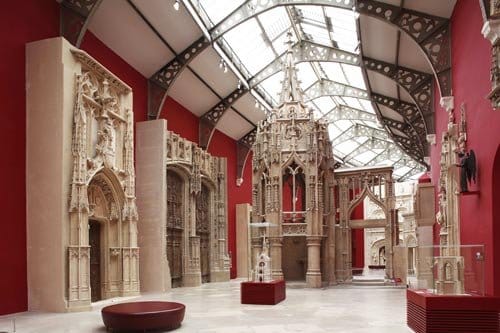10.06.2009 | what’s on
by Cité de l’architecture et du patrimoine
The conference will be held in English.
Papers and presentations are expected to be analyses rather than mere
case-studies.
Proposals are to be submitted before Friday, July 17 th 2009.
Abstracts in English should not exceed 250 words and must be accompanied by a short CV.
.
They are to be addressed to chair of session, with a copy to Corinne Bélier
cbelier@citechaillot.fr and David Peyceré, dpeycere@citechaillot.fr at the Cité de l’architecture et du patrimoine.
Session 1. Changing Institutions – Mergers and Partnerships
Round table with chair + 6 speakers, 10’ presentations
chair: Dietmar Steiner, director of the Architekturzentrum, Vienna
The stand-alone Architecture Museum, with the whole program of collection,
research, exhibition, library, publication, education, excursion, is a relatively
new phenomenon in the general history of Museums. The subject of
Architecture in the context of a ‘museum’ appears in different positions.
Historically established in departments of museums of fine arts, graphic
collections or libraries, the idea of an Architecture Museum is nowadays
confronted with cultural policies, which try to join or affiliate the subject of
architecture again with other disciplines like design, the building industry, or
getting integrated in general cultural institutions. This session will ask for the
experiences of icam members who are concerned with this kind of policies as well as their analysis about future developments. On a more general level, the session will discuss the autonomy of architecture as a discipline of art and the connection with other system of cultural rules.
Proposals to: steiner@azw.at
Session 2. The Icon and the Star
Chair + 4 speakers, 20’ papers
chair: Ulf Grønvold, Chief curator Architecture, The National Museum of Art,
Architecture and Design, Oslo
In the Middle Ages the Gothic cathedral was the proud symbol of its city.
Today the Sydney Opera is the trade mark for a whole continent in the same
way as the Eiffel tower reminds us of Paris. The modern cult of the star
architect has made the desire for the unique building much stronger:
nowadays for instance a new museum shall not just function perfectly but also look differently from anything you have seen before. Buildings with special qualities will always present a main interest for architectural museums, but are we giving too much attention to the stars and the icon buildings and neglecting the general architectural fabric of our cities? This session will address the issues of iconic buildings used for city or country branding, of collecting materials from star architects, and of the balance between the ordinary and the unique.
Proposals to: ulf.gronvold@nasjonalmuseet.no
Session 3 Challenges and Opportunities: Building up an Archive
Collection
Round table with chair + 6 speakers, 10’ presentations
chair: Sofie de Caigny, Coordinator, Centre for Flemish Architectural Archives (Architecture Institute Flanders), Antwerp
Never complete though overabundant, architects’ archives often lack
important information. The number of architectural practices who still possess their records is tremendously beyond the number of holdings taken in charge by collecting institutions so far. How can those institutions – architectural museums and archives – build a documentation or collection strategy from such a fragmentary material? The issue raises many questions. Can sampling policies be imagined? Can different holdings enrich one another and build up consistent series? Should architects be warned against their attempts at disposing of some of their records, or against their various representation strategies? Does the new digital environment add pressure on these choices?
Is an entire generation of born-digital architectural projects at risk of not being documented, putting the question ‘which archives of which architects to collect, how and why’ more at stake than ever? The session will examine how archives can define their mission statement, build up clear collecting lines, and follow them in spite of (growing) contingencies.
Proposals to: sofie.decaigny@vai.be
Session 4. Do not Judge the Book by its Cover: Architecture Books
in Exhibitions
Chair + 4 speakers, 20’ papers
chair: Irena Murray, Sir Banister Fletcher Director, British Architectural Library, Royal Institute of British Architects, London
The architecture book has played a fundamental role in the dissemination of
ideas, their cultural transmission and eventual transformation. The book
remains an integral part of the architectural project today, while its sequential nature often defies its claims as an object in the context of architectural exhibitions. This session will draw upon the specificity of architectural books to explore how the 21st century curators, conservators, book- and exhibition designers engage with architectural books alongside drawings and other types of visual representation. It will examine the means of enabling books as both narrative and physical objects in architectural space. Finally, it will explore the opportunities and modes of exhibiting books by virtual means or in on-line exhibitions. This session invites us to see how we can make architecture books in exhibitions more “present” to the visitors.
Proposals to: irena.murray@inst.riba.org
Session 5. Exhibitions: the Place of Text
Chair + 4 speakers, 20’ papers
chair: Marc Treib, Professor of Architecture Emeritus, University of California, Berkeley
Given the widespread prominence enjoyed by images in today’s world, what is the role of the text in architectural exhibitions? While it is said that one picture is worth a thousand words, one can imagine certain situations in which several words might perform more effectively than any image or object. This session will examine the place of text within exhibitions today: curator’s statements, identification labels, didactic explanations, tools of propaganda. Why and how should texts be constructed and take graphic form? What lengths and styles best engage and inform the visitor? How do the content, context, typography, and the positioning of text contribute to the legibility and impact of the exhibition? This session invites submissions from curators, educational staff, historians, and graphic and the exhibition designers that examine the considered use of text in printed or electronic form.
Proposals to: mtreib@socrates.berkeley.edu



